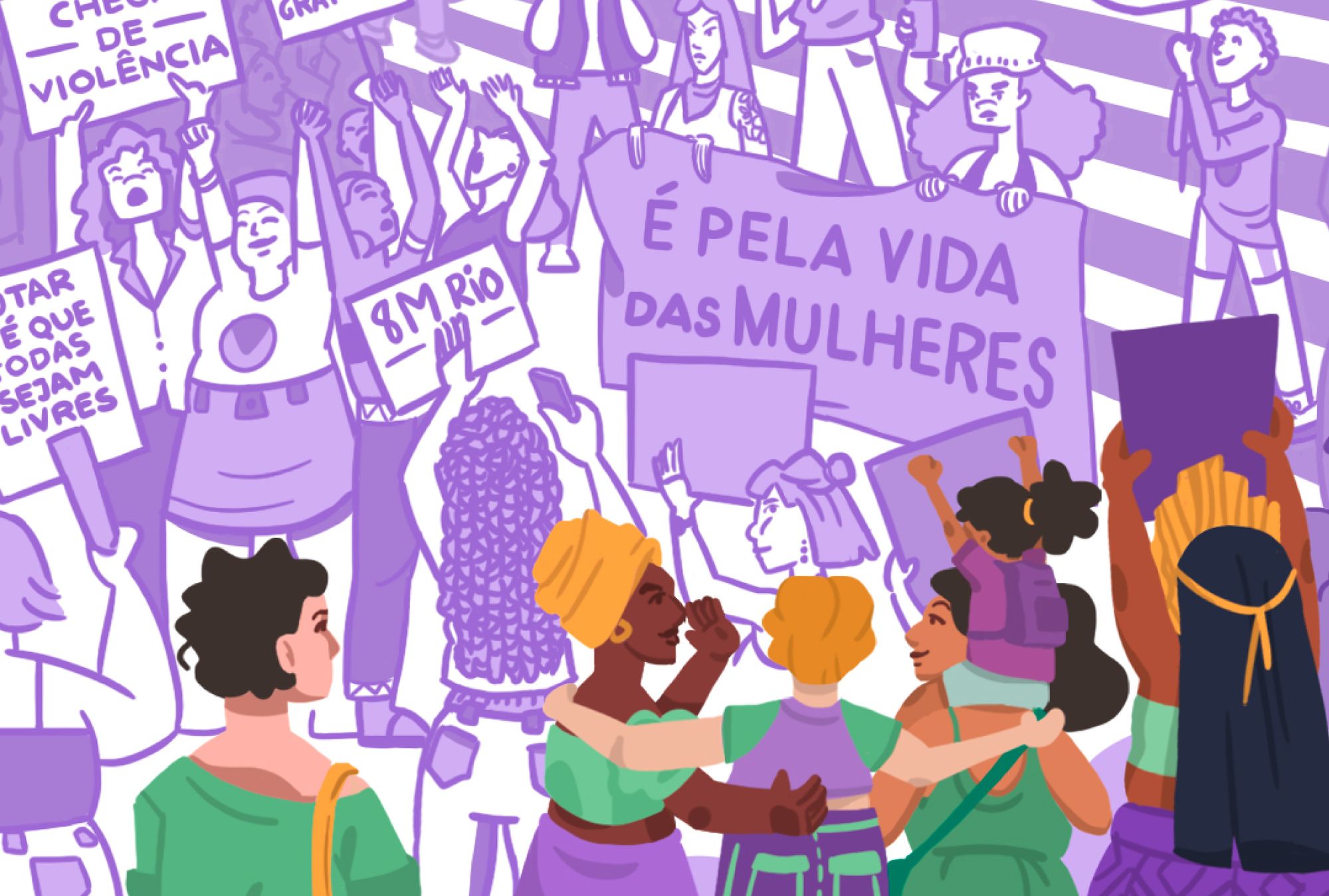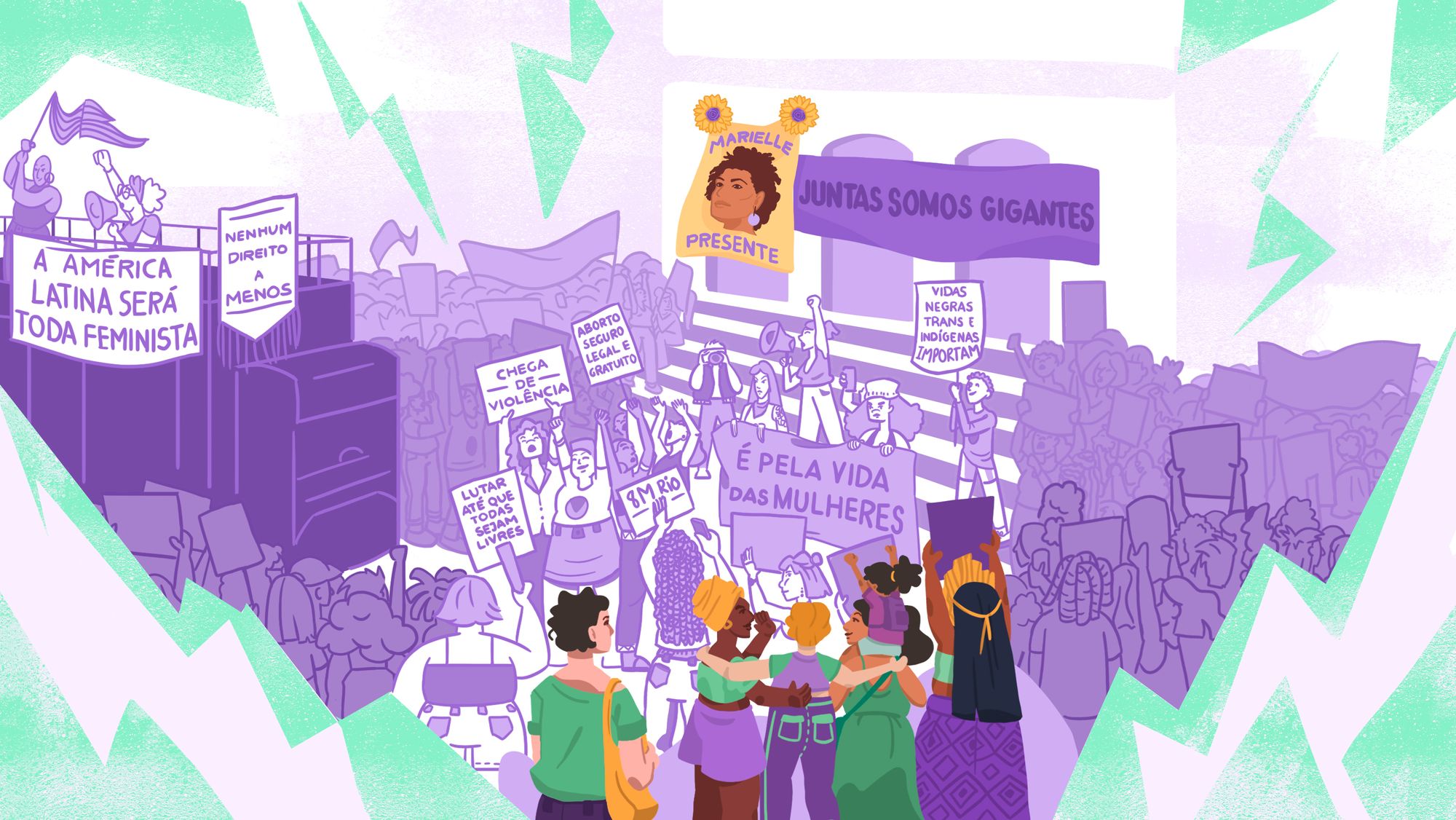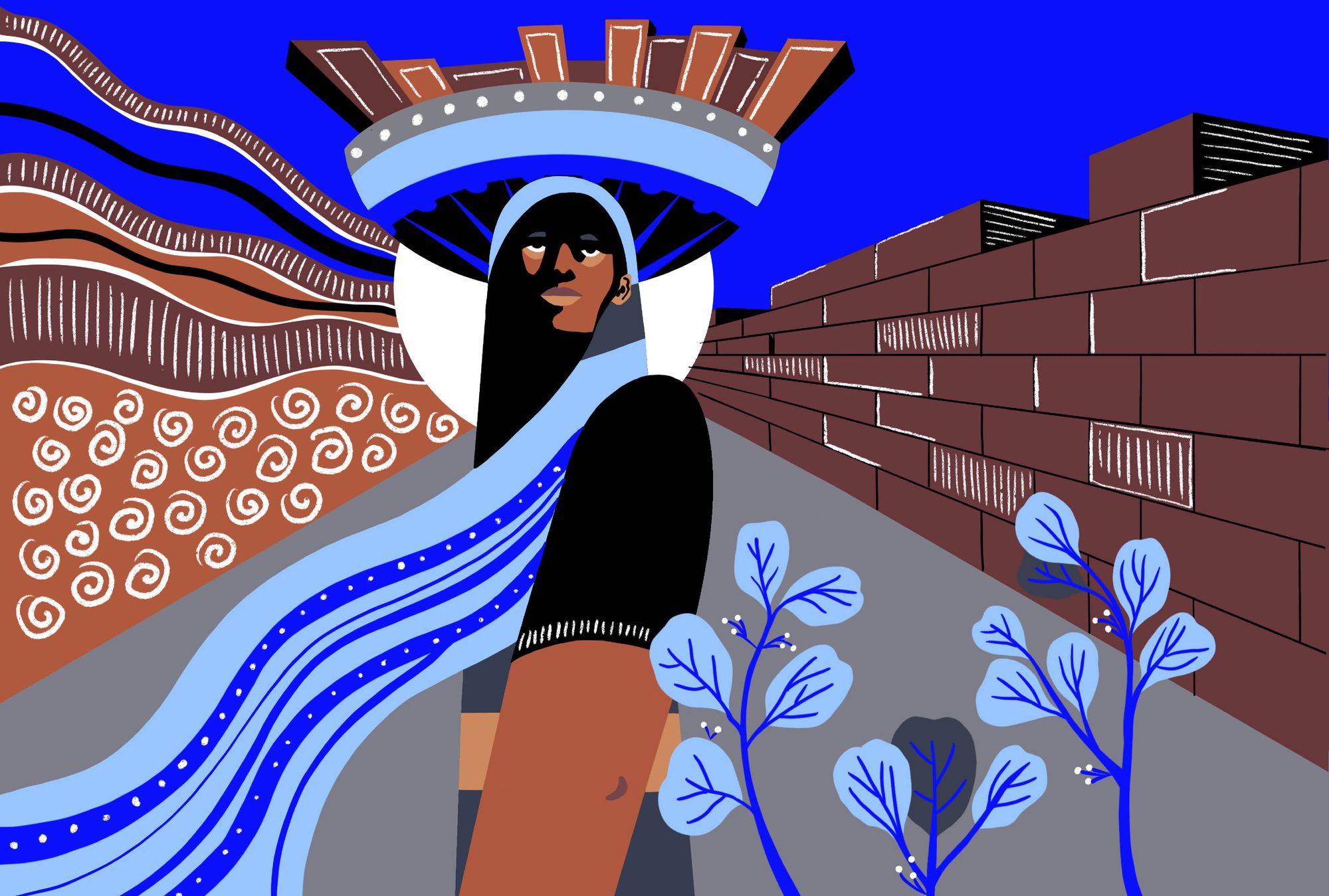
Trigger warning: Before you start reading, please note that this texts describes incidents of sexual violence.
Today is March 9, 2020, the first day of my design master’s degree. It’s a typical hot summer day, and I am on my way to the “8M”—short for March 8—the biggest feminist demonstration in the city of Rio de Janeiro. Since its inception in 2017, traditionally it is held on March 8, International Womxn’s Day, but this year as the date fell on a Sunday, the organizers moved the event to the next day, to improve visibility and logistics. The 8M takes place downtown, in the historic, administrative and financial heart of Rio. Its fixed date and location helps build the social imaginary around the demonstration, and brings activists and militants from all over the state.
“I’ve been going to the 8M demonstrations for the last two years as a feminist and an activist, but this time I’m also going as a design researcher.”
I am happy and excited to be studying a subject matter that interests me so much; one that is such an integral part of my daily life, my existence, and my every breath. My MA is about the relationship between feminist movements and design, and it challenges the patriarchal, cisheteronormative, racist, colonialist, ableist, classist and capitalist bubble of design. I’ve been going to the 8M demonstrations for the last two years as a feminist and an activist, but this time I’m also going as a design researcher.
I am anxious, as I’ve been actively involved in the collaborative planning—or designing—of today’s demonstration. The 8M is jointly organized by union members, left-wing political parties such as PSOL, PT and PCdoB, collectives like Juntas!, Resistência Feminista, Articulação de Mulheres Brasileiras, and organized fronts like CUT and SEPE. However, the invitation is also open to the general public, so I joined. In recent years, student and youth movements have become more popular in the city, and the majority of the organizers are young womxn, joined by a group of veterans that have been organizing demonstrations for many years. Many are public employees, educators, and trade union members who have long been engaged in fighting for labor rights and public services. During the past two months, I joined various plenary sessions in preparation for today’s event, participated in debates and online mobilizations, met many new people and made friends.
One of these is Dri Herz, an activist, organizer, and member of Juntas!, the biggest feminist collective of Brazil, which brings together more than 500 people across the country, and has over 24,200 followers on Instagram. Like many, Dri considers the 8M to be the biggest feminist event of the year, but she notes that the date is increasingly becoming co-opted by capitalism through news and advertisments. This growing commercialization, however, also reinforces the social imaginary around the date.
I’m shy and introverted, and I usually never go out alone, much less to attend demonstrations, which often pose security risks. But my resolution for the new year is to be more independent, and to do more things I feel like doing, even when I have no company. Today’s demonstration is such an occasion.
“I can hear the chants of: ‘Legalize it, the body is ours, it’s our choice, it’s for women’s life!’ and ‘Watch out, watch out, you sexist prick, Latin America is going to be all feminist!’”
It’s a personal achievement to be here alone. I feel very comfortable and complete, like I’m in the right place—the way it has to be. It’s 4 p.m., and the main event will start at 5 p.m. I’m in the Candelária square, in front of its namesake church, which is one of the most traditional tourist attractions in the city. This is an open space, with few trees and a fountain, which has historically been the locus for many demonstrations in the city, including the March of the One Hundred Thousand, a famous protest against the military dictatorship in 1968. The square is in the middle of downtown chaos, framed by two large avenues that concentrate most of the city’s public transportation lines.
I see the square slowly filling up, as I sit on one of the benches, watching a group of girls playing the drums, singing songs and adjusting their instruments. They are rehearsing, and I can hear the chants of: “Legalize it, the body is ours, it’s our choice, it’s for women’s life!” and “Watch out, watch out, you sexist prick, Latin America is going to be all feminist!” Strangers offer me stickers, newspapers, and pamphlets, and sometimes we talk for a bit.
When a journalist approaches me for an interview, I feel confident to speak. She is currently unemployed, but is covering the event because of her connection with the feminist cause. She asks permission to record me. In the future, I won’t remember my answer in detail—over the next twelve months, my political, academic and personal views will take a huge leap. The person who I am today, in March 2020, will not be the same person I’ll be in March 2021. I stress to the journalist just how comfortable I feel here, and how comfortable I’ve been to get involved in the organization of the 8M. I tell her that it is important to be on the streets together, and to build feminism for the 99%.

In recent years, a wave of conservative neoliberal governments swept the world, with the 2018 election of Brazilian president Jair Bolsonaro—a man who is outspoken about being homophobic, misogynistic, and racist—as an horrific example. This bolsters the powerful conservative influence of religions such as neo-Pentecostalism, which only accepts the monogamous heterosexual family unit, thereby discriminating against the entire LGTBQIA+ population. Currently in Brazil, many religious leaders oppose policies that promote sexual education and birth control. For example, the national Minister of Women, Family, and Human Rights, Damares Alves, who was appointed by Jair Bolsonaro, is an Evangelic pastor who calls herself anti-feminist, and advocates for the criminalization of abortion.
“In Latin America, organized feminist movements like Ni Una Menos in Argentina and Coletivo Las Tesis in Chile have helped to pave the way for the 2017 Feminist Strike, which brought together womxn from over 50 countries.”
All over the world, womxn have been mobilizing against these forces. In Latin America, organized feminist movements like Ni Una Menos in Argentina and Coletivo Las Tesis in Chile have been extremely important, and helped to pave the way for the 2017 Feminist Strike, which brought together womxn from over 50 countries. In Brazil, these efforts can be traced back to the 2013 June Journeys, a series of protests prompted by an increase in public transportation costs, which quickly spread to over 130 cities in the country, mobilizing over a million people over demands such as fighting corruption and police brutality. While the June Journeys kicked off a nationwide network of activists, at that point these initiatives were mostly led by men. Two years later, however, the country saw a wave of protests led by womxn, in what became known as the Feminist Spring.
It all started in 2015 with an outburst against a law proposed by Eduardo Cunha—the federal deputy at the time, who is now currently imprisoned for corruption—which was aimed at making it more difficult for rape victims to access essential medical care and abortion. Then, in 2016, the collective rape of a 16-year-old girl by 33 men in the West region of Rio de Janeiro led to another series of uprisings. In 2018, the brutal murder of Marielle Franco, a bisexual Black left-wing councilwoman from Rio de Janeiro—whose investigation remains unresolved, although numerous allegations connect her death to current president Jair Bolsonaro—galvanized another wave of nationwide demonstrations. Later that same year, #EleNao erupted as a movement against the election of Jair Bolsonaro, with protests and demonstrations in over 160 cities of Brazil, as well as 50 other countries around the world—the largest demonstrations organized by womxn in the history of the country.
“There are, however, clear divisions within contemporary feminism in Brazil. Liberal feminism, for example, does not take into account the intersections of class, race and other oppressions, and only understands ‘gender’ as a single lens for demands.”
Most recently, another wave of feminist protests swept Brazil during the height of the COVID-19 pandemic. The first was in August 2020 when Minister Damares Alves tried to prevent a 10-year-old, who had been raped for years by her uncle, from accessing abortion proceadures that are guaranteed by law, putting the child’s life in danger. Damares Alves also spread confidential data, generating conservative protests outside the hospital where the child was being treated. The second instance was incited in November, when a man was proven to be guilty of “rape with no intention of raping”—a crime which does not exist in Brazllian law, and therefore he was eventually released. The uprising was so enormous that a demonstration was organized in a few days with womxn leaders—who, until then, were not part of groups that usually organize feminist demonstrations in Rio de Janeiro. After months of smaller acts, this demonstration left its mark on the protests held during the pandemic.
There are, however, clear divisions within contemporary feminism in Brazil—as there are in contemporary feminism in general. Liberal feminism, for example, does not take into account the intersections of class, race and other oppressions, and only understands “gender” as a single lens for demands. Liberal feminists are known for preaching ideals of empowerment, entrepreneurship, and corporate feminism; but they aim for few women to enrich and occupy positions of power in order to continue reproducing the logic of patriarchy. In Brazil, social reproduction work and care work are poorly paid or most often unpaid. Teachers, nurses, and domestic workers, among countless other professions which are primarily performed by females, are part of an invisible working class, which makes up the strength that sustains society and the current capitalist logic. In this context, only a few—mostly white—women ascend in their professional and personal lives, at the cost of exploiting the labor force of lower class womxn—who in this country are mostly Black, indigenous, and womxn of color.
“It is not in our collective interest to engage in a ‘struggle’ that benefits only a small percentage of the population.”
In the city of Rio de Janeiro, extreme wealth lives side by side with extreme poverty. In neighborhoods like São Conrado, luxury buildings with 24-hour security, butlers, drivers, employees and private jets stand next to the favela of Rocinha, the largest community in Latin America, which is home to countless families, workers, children, schools and plural lives that are far from the stereotype of the favelado commercialized in movies and soap operas.
In such a context of blatantly brutal inequality, there cannot be any room for liberal feminists to preach their ideology. It is not in our collective interest to engage in a “struggle” that benefits only a small percentage of the population. It is for these and many other reasons—I could make a list of the atrocities and inequalities that we face on a daily basis not only in Brazil, but in the world—that I advocate a feminism for the 99%, a concept developed by Cinzia Arruza, Tithi Bhattacharya and Nancy Fraser. These authors understand the urgency of an anti-capitalist and anti-racist struggle that embraces the complexity of lives in the world. It is urgent that we look ahead to the future, in order to transgress the status quo and leave none of us behind.

The Candelária square is now almost full, and people are starting to group themselves. Many children are still playing and making posters with their mothers around the center of the square. My friend finally arrives shortly before the demonstration officially starts with a series of speeches from the top of a sound car, a truck packed five meters high with large speakers, which echo far down the avenue. On top of the car are around 10 womxn, each taking turns.
“The slogan ‘Bolsonaro Out!’ is always present, and most womxn claim for more reproductive rights, for the end of Black and indigenous genocide, for environmental preservation, for quality public health system, for quality public education, [...] among other agendas.”
For the most part, the speeches have similar agendas. The slogan “Bolsonaro Out!” is always present, and most womxn claim for more reproductive rights, for the end of Black and indigenous genocide, for environmental preservation, for quality public health system, for quality public education, for more labor rights, and for better care of the CEDAE (the city water company that provides water unfit for drinking), among other agendas. The speeches, applause, audience reactions, police whistles, and cacophony of musical instruments and conversation buzz combine to create a unique soundspace.
After the last speaker, everybody starts walking in an organized fashion of “blocks” towards Cinelândia, another landmark square in the historic center of Rio de Janeiro. There is a block for womxn with music instruments, and of womxn holding large banners with words like “Being a womxn is a political act!” and “Being Black is my essence, not my sentence!” Specific collectives walk together, and there is a special area for mothers with small children, who are surrounded by volunteer security workers. My friend and I walk on the right side of the sound car, away from the direct speakers—it’s a surprisingly calm place where we can listen to the songs, sing together, and talk. I meet people from many different eras of my life—a friend who studied with me in kindergarten, the father of my younger brother’s friend, and some women I met during the organizing plenaries. I know most of the songs because I’ve heard them in other demonstrations: “Companion, help me, I can’t walk alone, I walk well alone, but with you I walk better!” and “The state is secular, it cannot be sexist. The body is ours, not the moralist politicians’. Womxn are in the streets for liberation. A rapist’s place cannot be on the birth certificate!”
When we cross the Carioca square, which is the middle of the path, the sound car stops to honor Marielle Franco. Many people carry signs with her name and plastic sunflowers. The sunflower became the symbol of the fight for Marielle, because when the sunflower dies it scatters seeds, and that is exactly what she did. She left seeds of struggle and the will to resist, provoking a national uprising that won’t end anytime soon. Everyone kneels to sing the 2019 samba of Mangueira, a famous samba school of Rio, which centered on “Black, Indigenous and Poor” and honored Marielle. We begin singing low but as we stand up, we increase our voices: “Brazil, it’s time / To hear the Marias, Mahins, Marielles, Malês / Mangueira, take the dust out of the basements / Oh, make way for your barracão heroes...” Raising our voices to their maximum, everyone is jumping and screaming. It is beautiful! My eyes fill with tears. I get very emotional and hug my friend.

The 8M is part of the contemporary fourth wave of feminism, which is decidedly queer, intersectional and global; and uses the tools of digital communication to mobilize and disseminate messages across divides. Both internationally and in Brazil, there has also been a spike in the number of feminist publications, such as the anthology of texts entitled Pensamento Feminista Brasileiro, edited by Heloisa Buarque de Hollanda; and the book series Feminismos Plurais, edited by Djamila Ribeiro. This greater exchange of ideas feeds back into activism. The Internet and social media have also massively facilitated forms of transnational resistance, organizing and solidarity. In addition, new ways of occupying the street and of using the body through performance create a language that is specific to our contemporary time.
“Feminist movements, both in the past and today, only occur due to the concerted action of different organizations on several fronts, political parties, collectives, unions or even neighborhood groups.”
One significant example is the performance “Un violador en tu camino” by Chilean group Coletivo Las Tesis. The performance was created to denounce the police violence and abuse in the Chilean protests, and to put the issue of abortion and women’s rights over their own bodies on the agenda. Composed of a song and of choreography full of meaning and references to police officers, rubber shots in the eyes of protesters, and improper police searches; the performance went viral around the world through social networks. Using reference videos and creating a transnational network, the act was reproduced in more than 20 cities, adapting the lyrics of the song to the context of each place. Here in Rio de Janeiro, we added: “Present, present, Marielle is present! Seed, seed, Marielle is present! And her killer is a friend of the president!”
Feminist movements, both in the past and today, only occur due to the concerted action of different organizations on several fronts, political parties, collectives, unions or even neighborhood groups. The gathering of bodies is extremely necessary for stimulating dialogue around common ideas. As Argentinian author Verónica Gago explains: “Assemblies are constituted as situated devices of collective intelligence. They are spaces of rooting and projection where one experiences the power of thinking together, of elaborating an idea (a slogan, a route, a convocation, etc.) that did not exist before the assembly was held.”
“Design can also be understood as the process of organization, creation and subjectivation of the feminist movement itself.”
In all of that, there’s design. Although most people identify the role of design in feminist activism as merely that of producing the graphic materials such as posters, banners, flags, buttons, and other visual items for protests and demonstrations; design can also be understood as the process of organization, creation and subjectivation of the feminist movement itself. This requires reframing design not as a final product, but as a lens or a process.
Historically, design as a professional field and discipline has been detached from its social and political contexts, being mostly associated with aesthetic embellishment of objects, or functionality and efficiency of industrial products. In that framework, designers have been placed on a pedestal, as “creative geniuses” capable of proposing universal solutions for all of humanity. Such an approach not only alienates the designers, who cannot understand their position (neither the boss, nor the worker on the factory floor), and misleads consumers (with the use of “cool” terms such as design thinking and corporate marketing strategies); but it also reinforces neoliberal logic, which produces individualists who care solely for their individual problems.
“It is up to designers to adopt a critical perspective on the profession in order to rethink [...] the uncontrolled (re)production of hegemonic and normative values.”
Capitalism silences, alienates and oppresses the majority of individuals—those who produce goods and services tirelessly. It is up to designers to adopt a critical perspective on the profession in order to rethink this uncontrolled production, especially the uncontrolled (re)production of hegemonic and normative values, which directly benefit dominant groups, accentuating inequalities of gender, class, race, ethnicity, ability, and more.
Design can also be a profession capable of materializing ideas and metaphors, which builds and shapes the material culture and social imaginary of individuals. I believe that we have methodological and aesthetic tools at hand that can potentially create transformations. As Denise Portinari and Pedro Nogueira, a duo of researchers focusing on topics related to gender, sexualities and design, state: more than making a design for politics, which “contributes to the mechanisms of governability,” we should create a truly political design, promoting constant reformulations and creating “spaces for the subject to be produced in the collision with what is in front of him.”
Bringing design theory closer to queer studies, Denise Portinari weaves an essential thought for the practice of a truly radical and counter-normative design. For Portinari, queering design would make the field more aware of the political, ethical, aesthetic, subjective aspects and effects of design in contemporary times, integrating it into the social process of configuration and sharing of our common spaces and sensibilities. As Portinari says: “Queering also means problematizing and deviating design’s participation in the (re)production and materialization of normative strategies, through the critical analysing of its insertion in these processes and proposing counter-normative perspectives and practices that unfold new possibilities of existence.”

As 2020 began, so did the planning for the preparation plenaries for 8M. The meetings were held downtown, at the headquarters of SEPE, the state union of education professionals. The meetings were very full—always with more than 100 attendees in the cramped space—but leaders of each organization mediated to ensure that everyone had equal say. I soon realized that the dynamics usually take place in a certain order. First, participants debate the political conjuncture of the country, and that helps to generate mottos or effect phrases, such as “Aborto legal, seguro e gratuito” (“Free, legal and safe abortion”) or “Pela vida das mulheres” (“For women’s lives”). Some participants also suggested picking up mottos used in feminist protests in other states, in order to create a network and a sense of unity across the country. For Dri Herz, the feminist movement has a responsive and combative character to political events. As she says: “It has importance in guiding what will be the general politics from the street movement.”
“Plenaries are spaces for thinking together, and occupying spaces of visibility and decision-making. But they go beyond—they are also spaces for fraternization, politicization, personal and collective growth, and for building networks of solidarity and support.”
Sessions were very dynamic, full of fervent discussions. Numerous details were taken into consideration, including the route through the city center, the choice of musical instruments, the sound car, the security around the event, and also how best to promote it. For each point, they listed tasks to be done, and organized themselves into voluntary, decentralized working groups and teams. Special care was given to writing a manifesto to be disseminated on social networks and read at the beginning of the 8M demonstration. We drafted, read, and reread the manifesto out loud, changing things in real time, swapping words, or cutting whole passages.
A group of womxn noted down the main points discussed, in order to produce a summary not only for the group present, but also for those who could not attend. Overall, there was an effort to find consensus through conversations, but at times some aspects had to be decided by vote at the end of the meeting.
However, this practice is rather recent. When Dri Herz joined the plenaries back 2017, some groups imposed their ideas on others, as there was no voting dynamic in place. As a newcomer, she often felt insecure, especially when she disagreed with more experienced womxn. Nowadays, she feels safer to defend her ideas. “But disagreements are very much integral to the process,” she points out. “People think that the womxn’s movement is all beautiful, but it's difficult. The result is rewarding.”
Plenaries are spaces for thinking together, and occupying spaces of visibility and decision-making. But they go beyond—they are also spaces for fraternization, politicization, personal and collective growth, and for building networks of solidarity and support.
“When we discover ourselves as feminists, we give up many things and people, and we move away from places that seemed good before but that can be very scary. This obviously doesn’t make this struggle easier, but it gives us much more strength.”—Natalia Knust
“It’s a wonderful energy to see so many people gathered for a cause that on a daily scale feels very lonely,” says pedagogy student Natalia Knust, who believes that the 8M brings out a lot of emotional responses. “When we discover ourselves as feminists, we give up many things and people, and we move away from places that seemed good before but that can be very scary.” For Knust, participating in the 8M makes the feminist struggles less lonely. She adds: “This obviously doesn’t make this struggle easier, but it gives us much more strength".
Being in the organization committee of the 8M demands a lot of energy and time, but for Dri Herz, it is empowering, and she considers herself to be “addicted” to demonstration. “I think it’s wonderful to see everyone on the street building collectively; it gives a sense of the world I want to live in,” she says. As Verónica Gago posits, assemblies and plenary sessions are at the same time “situation and process.” They make possible the plurality of visions, which are essential for the construction of a popular feminist movement, and also operate as an itinerant tool. They do not necessarily produce consensus, but invite the participants to listen to each other, and to feel the body in that space. As Gago states, plenaries “not only do what lasts, [...] but it prolongs the effects of what we intuit, think, desire and decide if they become body, and set in motion a whole set of perceptions, actions, debates and more convocations.”
After each demonstration, organizers receive many calls from others interested in participating. It is a moment of expansion, and of attraction for new participants. As Dri Herz says, “In general, more womxn feel the need to politicize themselves, to participate in something collective. Many also look for political organizations to participate in, and end up [becoming even more politicized].” This showcases the broad influence and reach of the 8M: it is feminism on the rise.

We continue walking until we reach the final stop at Cinelândia, another massive square in the city center, surrounded by pompous buildings including the Municipal Theater, the Fine Arts Museum, the National Library and the city’s Legislative Assembly. It takes a few minutes until people reorganize themselves in the space and occupy the steps of the Legislative Assembly. Now we are in front of the sound car that has stopped at the side of the staircase, occupying the street. This way, we can hear the next series of speeches. Most of the womxn who speak are candidates, politicians, or leaders of collectives—representatives of the movement. I look at the staircase of Cinelândia crowded with people holding a huge banner with hand-painted purple letters saying: “Together we are giants.”
It is already 9 p.m., and I am starving and tired. My partner met us along the demonstration, right after the stop to honour Marielle, and it was only when we stopped at the square that the three of us were able to stop to talk. We stay there for some time, but weariness makes it difficult to pay attention to the speeches in the midst of so much noise. The square gradually begins to empty out, and we decide to go somewhere quieter for dinner.
“If design wants to be a practice of autonomy and freedom, these processes of collective build-up that value a plurality of experiences are the paths to be explored.”
Between many pizza slices and beer, we reminisce about the day, and we remember the most emotional moments. Even though the three of us were in the same place, our impressions and memories of the event are very different. Our conversation unfolds fluidly from today’s event—to sexism on TV and public incidents of violence, and to episodes that happened to others close to us. We are deeply immersed in sharing sensitive memories and uncomfortable moments of harassment—from street whistles, to how people who once were important in our lives have deeply hurt us. These stories were kept secret for such a long time, but now we are ready to share them out loud.
We say goodbye at the pizzeria. As I’m in an Uber going back home, I feel a deep sense of happiness. I’m proud of myself for having lived what I helped to build. Design can learn so much from the collective organized feminist movements, such as the 8M and many other left-wing movements. If design wants to be a practice of autonomy and freedom, these processes of collective build-up that value a plurality of experiences are the paths to be explored. When I lie in bed, my head is still bubbling. Despite my exhaustion, I am thinking about a thousand things. I want to talk to someone, to take these experiences back to my master’s degree, to study more. I feel that this is just the beginning of my journey as a militant, feminist, designer and researcher.
Nina Reis (she/her) is a fashion designer currently pursuing her MA in design at PUC, Rio de Janeiro, Brazil. Her research focus is feminist collective practices, critically emphasizing design as (re)producer of normativity. Besides, Nina is the founder of MIA, a fashion, illustration, and art course for children and teenagers. She also works as a freelancer on visual identities and fashion styling, focusing mainly on social media.
This text was produced as part of the Troublemakers Class of 2020 Workshop.














